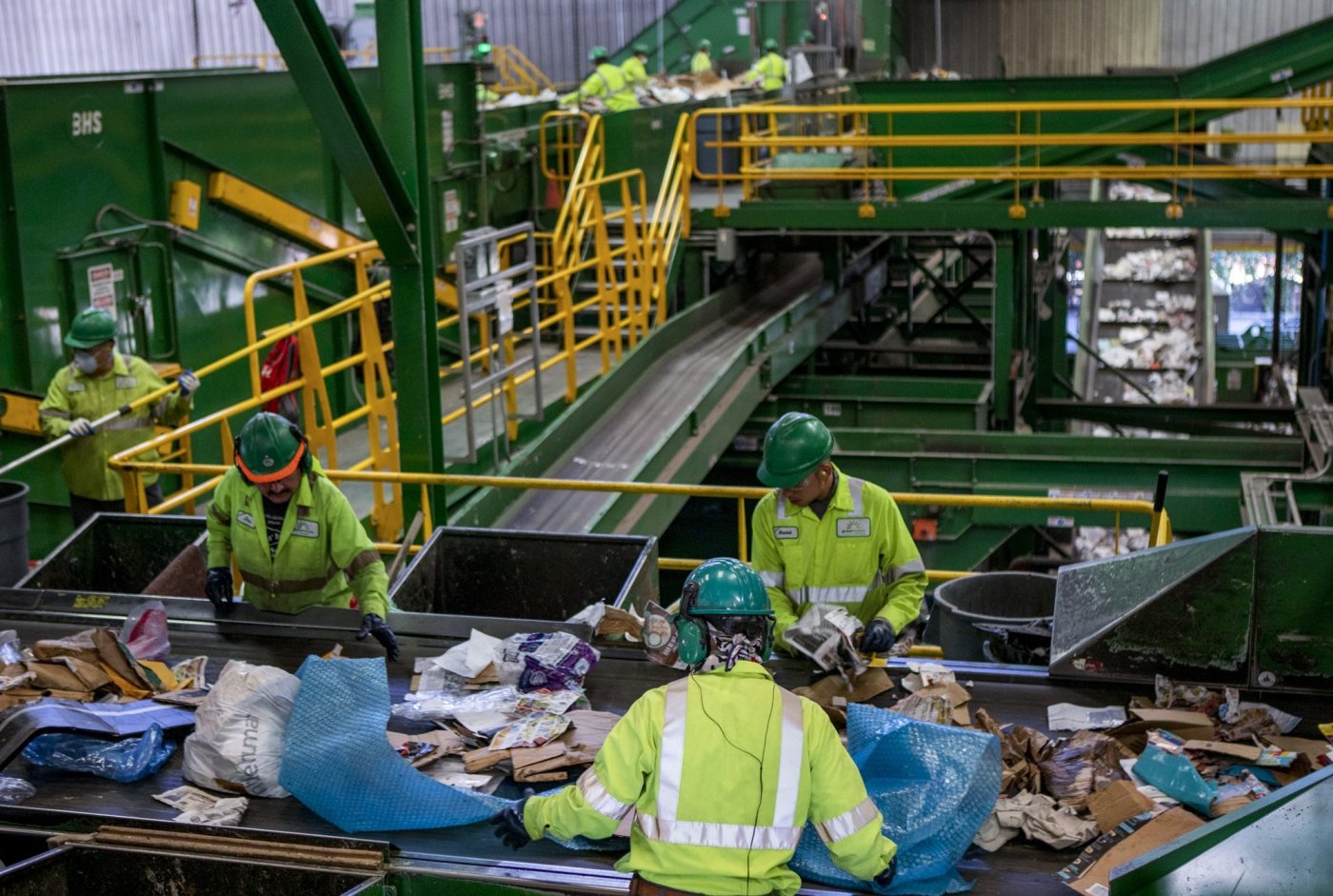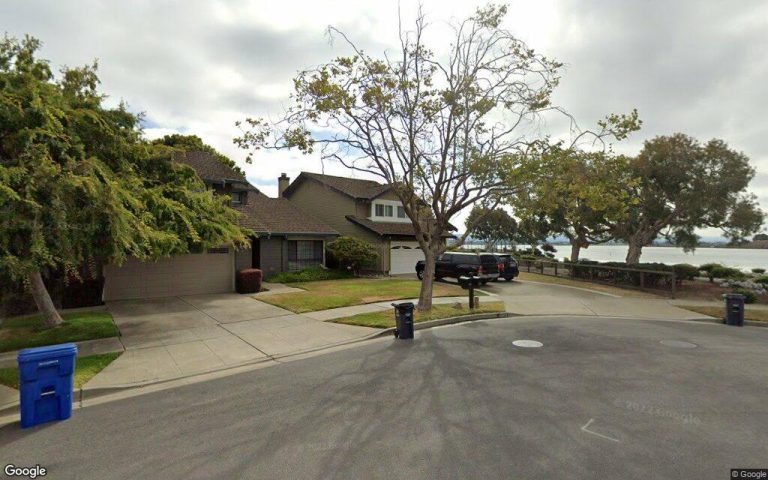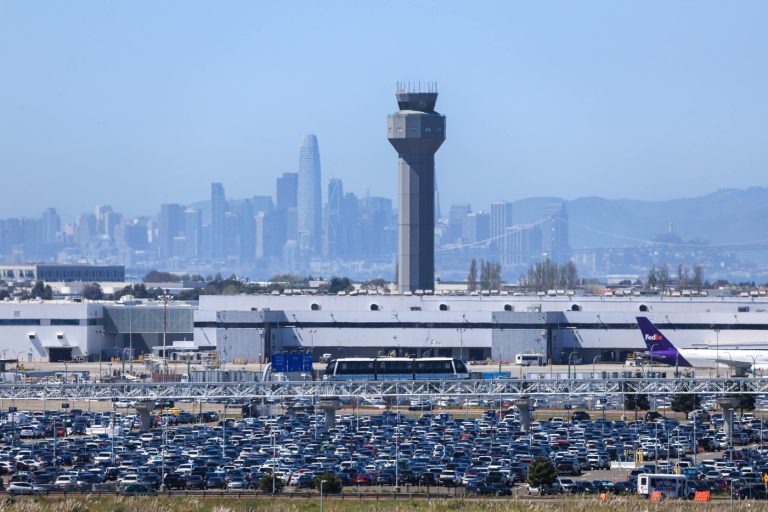Inside the GreenWaste Material Recovery Facility in San Jose, both human and mechanical hands work to separate the pieces of ink-stained paper, dented multi-colored plastic and crushed metal that can be resold and recycled from the piles of collected material. A wall of rotating metal disks slaps against clean cardboard as workers pull thin plastic bags off the belt by hand. Aluminum cans are flung into a chute by pressurized air.
But if processing recyclables is complicated, the web of resale markets they move through is even more tangled.
In the Bay Area, the journey of a recycled aluminum can or plastic bottle is managed by contractors who must adhere to a wide range of local regulations as they collect and process the materials. As cities grapple with issues of recycling contamination, the recently heightened threshold for clean materials has led to more success in making sure these items are actually recycled — but the fragmented system still has gaps that need to be addressed.
Just three recycling companies handle the collection and processing of recyclables in four major Bay Area cities: GreenWaste works with San Jose and Palo Alto, California Waste Solutions services Oakland and San Jose, and Recology manages curbside recycling in San Francisco. For most cities in Contra Costa County, Republic Services handles residential recycling, while Mt. Diablo Resource Recovery manages Concord.
This patchwork of local governments, recycling haulers, material recovery facilities and end-users means that the items acceptable for recycling differ from city to city.
“More broadly, it’s not the city, it’s not CWS, it’s what third-party companies are willing to receive to make into new products,” said Rebecca Parnes, a recycling specialist with the city of Oakland.
Before the passage of China’s Green Fence and National Sword policies in 2013 and 2018, respectively, Western recycling didn’t necessarily result in the actual repurposing of the paper, plastic and metals that were shipped overseas.
Until the early 2010s, China was a large consumer of recyclables because it needed raw material to feed its growing manufacturing sector. However, the “recyclables” that often filled empty Chinese shipping containers were low-grade, worthless plastics that were never recycled and ended up polluting the air and water.
The implementation of the Green Fence and National Sword policies limited imports of “contaminated recyclables” — those that had been dirtied or improperly sorted.
That led to a huge shift in where material ended up after leaving California since recyclers needed time to adjust to the new rules. The price for recyclables “fell off a cliff,” said Colin Staub, an associate editor for Resource Recycling magazine.
To meet the demand, markets for collected paper and plastic, led by manufacturers, sprang up in the United States, Canada and several Southeast Asian countries, such as Vietnam, Thailand, Malaysia, Indonesia and the Philippines. Mexico and South Korea have also popped up as strong markets for recyclables to feed the needs of manufacturers, added Mark Murray, executive director of the nonprofit organization Californians Against Waste.
Representatives from GreenWaste, California Waste Solutions and Recology all confirmed that most of their recovered paper and cardboard usually ends up in South Korea and various Southeast Asian countries, such as Indonesia, Malaysia and the Philippines, to be recycled. Spokespeople for California Waste Solutions and Recology confirmed that plastics are processed in Asian countries and within the United States.
However, more recyclable materials are now being recycled within the United States, and that trend seems to be continuing.
In the years following China’s Green Fence and National Sword policies, exports of all grades of recycled plastic from the Port of San Francisco dropped. In 2014, almost 195 million kilograms of recycled plastic was exported from the Bay Area. In 2023, only about 5.7 million kilograms of recycled plastic were exported.
Exports for all grades of recycled paper have largely stayed the same in the last 10 years, between about 1.5 million and 2.1 million metric tons, due to other countries importing U.S. recycled paper since China exited the market.
Due to fluctuations in the market, about 90% of PET plastics, like those contained in water bottles, are recycled domestically, said Ricky Lopez, vice president of material recovery facility processing for GreenWaste. HDPE plastics, like milk jugs and detergent bottles, are recycled domestically and sold back to manufacturers.
“GreenWaste prioritizes sending 100% of its PET and HPDE plastic, like water bottles, milk jugs, and detergent bottles, to domestic recyclers. We also send other hard-to-recycle plastics, like film plastic, to domestic recyclers,” the recyclers stated.”
Palo Alto was the only city that didn’t export its mixed paper and mixed rigid plastics for processing in another country. Maybo AuYeung, the city’s environmental program manager, confirmed that the City Council pays GreenWaste to process the materials in the United States.
And while this system is still fragmented, it resulted in honest, record-high recycling rates for PET and HDPE plastics, Murray said.
“We know how to make recycling work. We know how to send the right market signal to processors to improve quality. And frankly, by having this almost fake market overseas where people could send poor-quality material,” Murray said. “That wasn’t helping anyone. That wasn’t improving the markets. That wasn’t incentivizing people to improve the quality.”
One possible solution to the continued fragmentation in the system is for states to pass extended producer responsibility laws, which would make manufacturers responsible for the life cycles of the products they make.
“That’s saying the people producing the plastic packaging and the single-use plastics, you should be the ones paying because it’s overwhelming our systems. It’s overwhelming our cities. Consumers can’t pay for it,” said Marissa Heffernan, an associate editor with Resource Recycling magazine.
Related Articles
Repair cafe at Saratoga Library helps divert trash from landfills
Recycletek puts AI in CRV in Sunnyvale
Milpitas residents can get free compost
Why ‘paper or plastic?’ may be coming to an end at California grocery stores
A California law was passed in 2022 to shift the responsibility for plastic pollution onto producers, known as SB 54 or the Plastic Pollution Prevention and Packaging Producer Responsibility Act. The goal of the law is to cut down the production of single-use plastic in packaging and food ware by 25%, recycle 65% of single-use plastic and ensure that all single-use plastic food ware and packaging are recyclable or compostable by 2032. The statewide regulations are expected to be adopted in 2025.
Only four other states have similar packaging laws: Colorado, Maine, Oregon and, most recently, Minnesota.
Heffernan said that a national Extended Producer Responsibility (EPR) law has been gaining traction with manufacturers who would rather comply with one program than hire more people to comply with EPR laws in the five states. And ultimately, the lobbying power for EPR is in the hands of these manufacturers.
“There have been hearings at the federal level, which is the babiest of first steps into getting something really going there. But if we see the big brands of the world saying, ‘Actually, we want this,’ that’s where the lobbying power is,” Heffernan said. “So I would both be surprised and not surprised in the next 10 years to see something happen at the federal level.”












